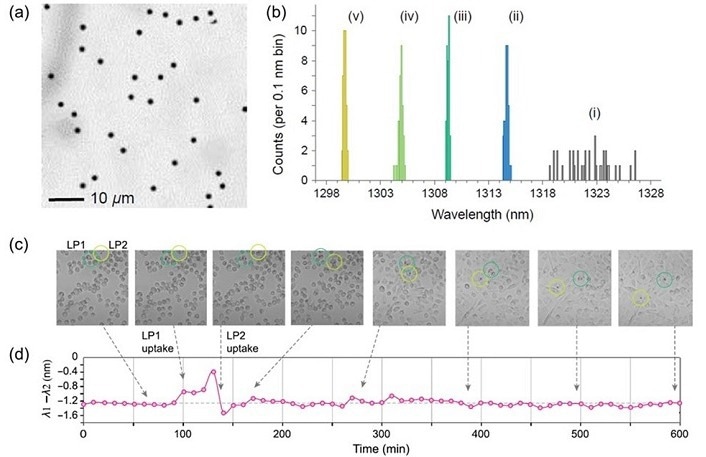Recently, nano- and microdisk lasers have become potential optical sources and probes for different applications in the industries of biomedicine and nanophotonics. Their capacity to gain lasing at an ultra-narrowband precision and deterministic wavelength is important for different applications in on-chip bioimaging, on-chip photonic communications, biochemical sensing, and quantum photonic information processing.

(a) Free-standing laser particles (LP) on a PDMS substrate. (b) Wavelength tuning by PEC etching of original microdisks (i) to give narrowband wavelength distributions (ii-v). (c) Optical micrograph showing cells with incorporated LPs. One LP (LP1) is internalized by a cell at ∼100 min, and another LP (LP2) is internalized by a different cell at ∼140 min. (d) Lasing wavelength differential of the two microdisk lasers in the cell culture over time. Image Credit: Sarkar et al., doi 10.1117/1.AP.5.5.056004
Nevertheless, the large-scale fabrication of those precise wavelength nano- and microdisk lasers is still difficult. The randomness in the disk diameter is introduced by the existing nanofabrication processes, which makes it challenging to attain deterministic wavelengths in laser batches.
Addressing this concern, a group of scientists from Harvard Medical School and Massachusetts General Hospital’s Wellman Center for Photomedicine has devised a breakthrough photoelectrochemical (PEC) etching-based method that enables accurate tuning of the lasing wavelength of microdisk lasers with subnanometric accuracy. Their research is published in the Gold Open Access journal Advanced Photonics.
The novel technique facilitates the production of nano- and microlaser batches with predetermined and accurate emission wavelengths. The application of PEC etching is fundamental to this innovation, providing a successful and scalable way to refine the wavelength of microdisk lasers.
In their research, the group efficiently achieved SiO2-capped indium gallium arsenide phosphide microdisks on indium-phosphide pillar structures. Next, by performing photoelectrochemical etching in a diluted sulfuric acid solution, they accurately controlled the lasing wavelengths of such microdisks to deterministic values.
Also, they examined the kinetics and mechanism that is fundamental to the particular PEC etching. Ultimately, they shifted the wavelength-tuned microdisk arrays onto a polydimethylsiloxane substrate, generating free-standing, isolated laser particles with different lasing wavelengths. The consequent microdisks displayed lasing emission with an ultranarrow bandwidth of below 0.6 nm for on-pillar lasers and less than 1.5 nm for the isolated particles.
This finding sets the stage for several new biomedical and nanophotonic applications. For example, the free-standing microdisk lasers can function as physical optical barcodes for heterogeneous biological samples, facilitating the tagging of particular cell types and the targeting of particular molecules in multiplexed assays.
Currently, cell-type specific tagging is conducted with the use of traditional biomarkers, like quantum dots, organic fluorophores, and fluorescent beads, which have wide emission line widths. Consequently, only a few particular cell types can be tagged concurrently. Contrarily, microdisk lasers, with their ultra-narrowband light emission, would facilitate concurrent identification of a higher number of cell types.
Hence, the team assessed and efficiently established the accurately tuned microdisk laser particles as biomarkers by utilizing them to tag live normal breast epithelial MCF10A cells in culture. Using their ultranarrow bandwidth emission, these lasers can possibly revolutionize biosensing with the use of well-demonstrated optical and biomedical techniques, like flow cytometry, cell dynamics imaging, and multi-omics analyses.
Considerable progress of microdisk lasers is marked by the PEC etching-based method. The scalable nature of the technique, in addition to its sub-nm accuracy, sets the stage for new opportunities for the numerous applications those lasers identify in biomedical and nanophotonic devices, along with the barcoding of specific cell populations and assay molecules.
Journal Reference
Sarkar, D., et al. (2023) Precise photoelectrochemical tuning of semiconductor microdisk lasers. Advanced Photon. https://doi.org/10.1117/1.AP.5.5.056004